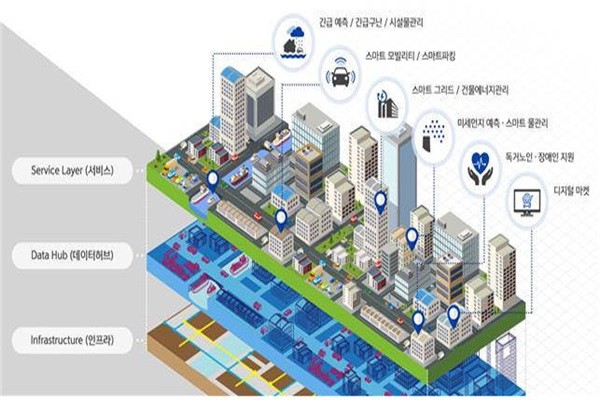Smart Cities that include urban design and state-of-the-art technologies such as AI, self-driving cars, and Smart Energy for Industry 4.0 will be formed in Sejong-si and Busan-si. These two cities will be transformed as Smart Cities that are applied with state-of-the-art technologies and improve quality of lives, test new technologies freed from regulations, and discover driving forces. Presidential Committee on the Fourth Industrial Revolution voted on ‘Smart City Promotion Strategy’ that is based on selection of 5-1 region (2.74 million m2) in Sejong and Eco Delta City (2.19 million m2) in Busan as national demonstration Smart Cities on the 29th.
Presidential Committee on the Fourth Industrial Revolution is going to implement various daily Smart City technologies based on energy and traffic for 5-1 region in Sejong and a connection between waterfront cities and international trades for Eco Delta City.
Presidential Committee on the Fourth Industrial Revolution presented ‘national demonstration city’ that has every aspect of Smart City technologies integrated on an empty site as an important strategy for Smart City project. It is not going to focus on access centered on simple technologies and Smart City policies led by the public but focus on having these cities emerge as open cities that are centered on various consumers such as private companies and citizens and cities that continue to carry innovative growth.
With six government departments such as Ministry of Land, Infrastructure, and Transport and Ministry of Science and ICT participating, these cities that will be established by end of 2021will be based on three basic directions such as test bed of technologies, solutions for city problems and improvement of quality of lives, and formation of innovative industrial ecosystems.
South Korean Government is going to focus on establishing state-of-the-art technologies such as IoT (Internet of Things), self-driving cars, Smart Grid, and VR (Virtual Reality) in these cities. It is going to demonstrate and commercialize future technologies such as next-generation network, Big Data, and AI based on innovative infrastructures in order to maximize level of convenience of residents.

South Korean Government is going to apply ‘regulation sandbox (grace period system on regulations)’ on these cities in advance so that it can support startup companies to test their business models and induce private investments. It is also going to focus its budget on R&D and policies.
South Korean Government is going to finalize on contents such as detailed budgets and technologies after going through additional discussions. It is expected that detailed plans will be finalized during a process of selecting additional cities after receiving proposals from local government bodies during the second half.
Presidential Committee on the Fourth Industrial Revolution is planning to continue its business of applying Smart City technologies to current cities.
Presidential Committee on the Fourth Industrial Revolution is going to push for ‘leading models of Smart innovative City’ that are connected to regional public organizations in local innovative cities. It is going to establish Smart Energy model with Korea Electric Power Corporation in Naju Innocity. In Kimcheon Innocity, it is going to think about establishing Smart Traffic model that is linked to Korea Expressway Corporation and Korea Transportation Safety Authority.
Presidential Committee on the Fourth Industrial Revolution is going to select four places such as current new towns and apply state-of-the-art Smart City technologies that are developed through national R&D. It is going to apply these technologies to old and worn-out cities and continue to push for ‘Smart City Recycling New Deal’ that improves living environment.
“Smart City is meaningful as a platform that implements every technologies and services of Industry 4.0.” said Chairman Jang Byung-kyu of Presidential Committee on the Fourth Industrial Revolution. “Openness where city problems are solved through participation from citizens and private companies is more important than others in order to solidify Smart City as lasting platforms.”
Staff Reporter Park, Jisung | jisung@etnews.com